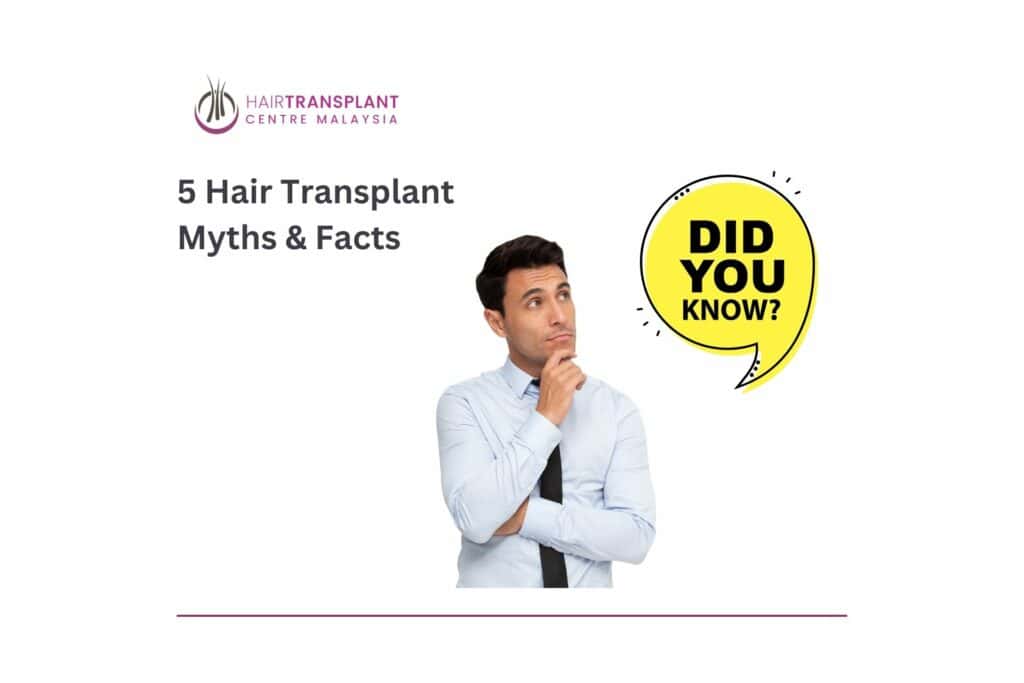5 Hair Transplant Myths & Facts
Hair transplants, like any medical operation, have a wealth of information available online. There is a lot of useful information available, but there is also a lot of misinformation. Today, we’ll look at five hair transplant myths and realities to see if what you’ve heard is accurate.
Let us call you

1. Hair Transplant Myths: Hair Transplants Hurt
Many individuals naturally believe that transplanting hair follicles from one part of the scalp to another will be uncomfortable. This is not true; most individuals believe that a hair transplant would hurt when, in reality, the surgery is painless.
Before we begin the treatment, we apply local anaesthetic to the region of the scalp where we will be operating. The only thing that could cause pain is the first injection, which may hurt a bit.
Our goal is to make every customer as relaxed as possible throughout their session. Every therapy room in our newly refurbished clinic has a TV, iPad, and music system. This will keep you engaged and take your mind off the operation.
Answer: Hair transplants are not painful, however they are occasionally unpleasant.
2. Hair Transplants are for bald people
This is totally false; in fact, it is precisely the contrary. Hair transplants can help you regain a full head of hair, but they won’t work if you don’t have any. We’ll need enough hair in your donor region to transplant to the remainder of your scalp, and we won’t be able to assist if you’re bald.
Advanced troche pigmentation, for example, may be used with little or no hair. The outcome is dependent on the hair quality and the patient. To learn more about ATP, schedule a no-cost appointment now.
Answer: It is not feasible to receive a successful hair transplant if you are entirely bald.
3. Quick Results
You’ll be able to see where the new hair follicles have been put immediately after your hair transplant, but results will take time. After 3-6 weeks, the transplanted hair will begin to shed. Following 2-4 months, the hair will begin to grow, and approximately 6 months after the transplant, you will be halfway to your desired result and will be able to observe good development.
This will all be described in greater detail both before and after your surgery. This can help you moderate your expectations and avoid being discouraged if you don’t notice quick, outstanding results.
Answer: Expect to wait 2–6 months for positive results.
4. The Effects Of Hair Transplantation Are Only Temporary
Some individuals feel that a hair transplant is only a temporary remedy to hair loss; yet, a hair transplant is the most permanent hair restoration procedure known, with incredibly long-lasting effects.
Your transplanted hair will behave the same as it did in the donor area, which means it will continue to grow normally. In most situations, this means that the hair will continue to grow for many years.
During your personal consultation, we’ll make sure you’re a good candidate for a hair transplant and look into your age, family history of hair loss, and kind of hair loss to make sure our procedure is suited for you. Although we cannot guarantee that the therapy will be permanent, we will do everything we can to make sure that it works as well as possible for you.
Answer: The outcomes are permanent.
5. Hair Transplant Myths: Every method yields the same results.
FUE (follicular unit extraction) and FUT (follicular unit transplantation) are the two most used procedures of hair transplantation (follicular unit transplantation). We exclusively provide FUE at Hair Transplant Centre Malaysia because it is the most sophisticated hair transplantation process that produces the most natural and realistic results.
Varied procedures provide different outcomes, therefore we believe it’s critical to learn about the many types of hair transplants so you can obtain the best treatment available. FUT, for example, was previously the most common method of implanting hair follicles, which is why it is still accessible today, but technology has fueled the emergence of FUE, which is safer and leaves less scars. Many clinics throughout the world provide FUT because they are unable to improve their equipment, yet scarring and trauma can have a significant influence on regrowth and outcomes.
Answer: The results can vary across different procedures.


